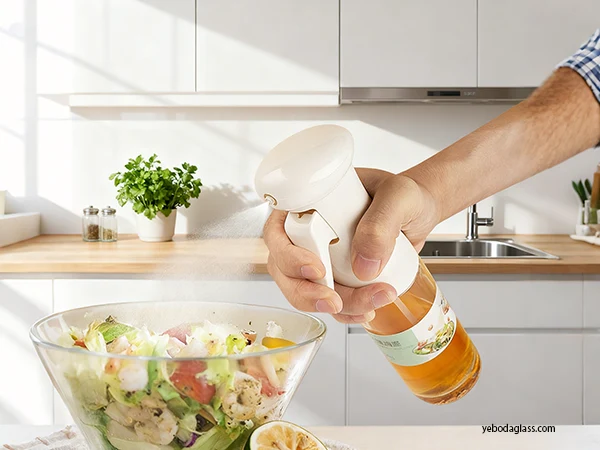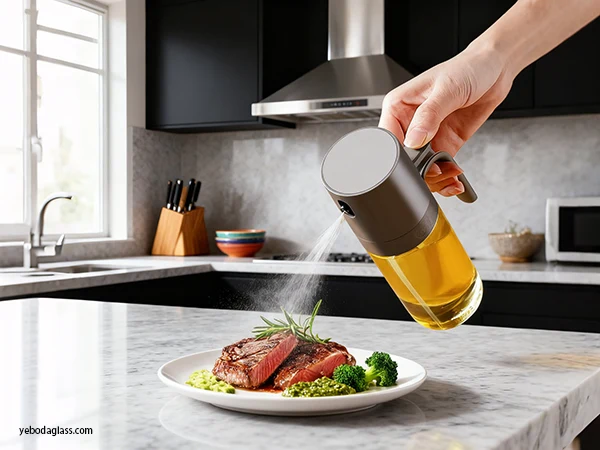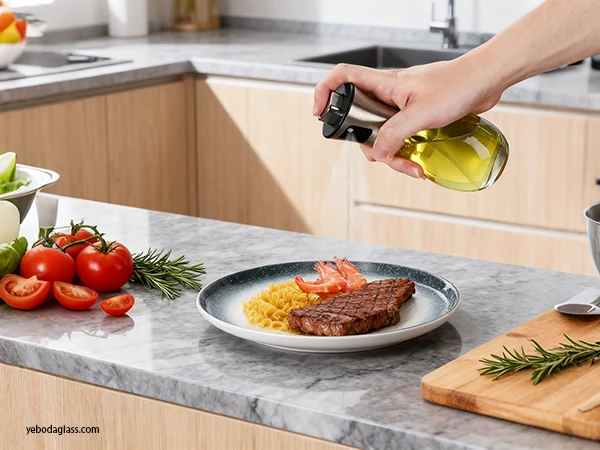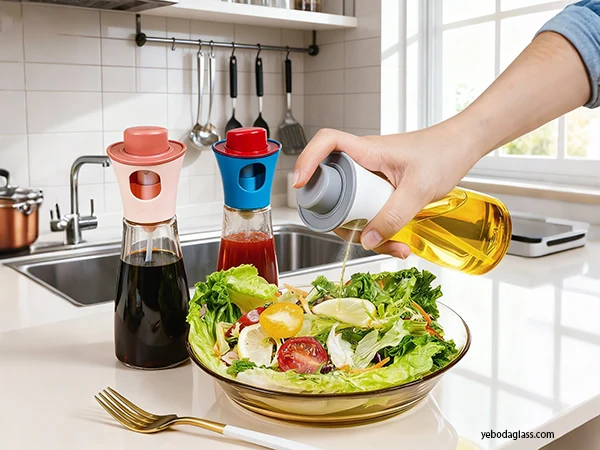Introduzione
Selecting the right cooking oil spray bottle is crucial for businesses in the culinary sector. This decision impacts operational efficiency, product quality, and brand perception. Inconsistent dispensing leads to waste and uneven cooking, while a well-chosen cooking oil spray bottle enhances precision, promotes healthier practices, and elevates brand image. This report provides a framework for strategically selecting cooking oil spray bottles, considering business needs, technical specifications, regulations, and trends. The Sì, sì. glass cooking oil spray bottle exemplifies a strong option, offering material inertness, aesthetic appeal, and controlled dispensing for premium quality and user experience. Its glass construction preserves oil integrity, while its design can cater to diverse culinary needs, making it an excellent choice for any business prioritizing quality and sustainability in their cooking oil spray bottles.

Oil Type and Dispensing Mechanism Compatibility for Cooking Oil Spray Bottle
Oil Type and Dispensing Mechanism Compatibility for Cooking Oil Spray Bottle
The viscosity and composition of cooking oils are key factors for your cooking oil spray bottle. Oils with varying viscosities affect mist atomization. Lighter oils like vegetable oil (88-500 cP) are generally suitable for misting sprayers. Thicker oils, such as olive or avocado oil, can clog standard sprayers, requiring cooking oil spray bottles designed for oils with trigger or pump atomizers. Yeboda’s glass cooking oil spray bottle, with its thoughtfully designed dispensing mechanism, often accommodates a range of oil viscosities, making it a versatile cooking oil spray bottle option. Aerosolized versus non-aerosol dispensing is significant for a cooking oil spray bottle. Non-aerosol sprayers (pump/trigger) offer controlled, propellant-free dispensing. Some require pre-pumping for continuous spray, potentially limiting fill volume. Others offer instant misting with low output per dosage. Material compatibility is vital; cooking oil spray bottles should be made from oil-compatible materials like HDPE, PP, or glass, with wide-bore tubing to prevent clogging. The Yeboda glass cooking oil bottle excels here, as glass is inherently inert and compatible with all cooking oil types, ensuring no chemical leaching and preserving the oil’s purity.
Viscosity of Common Liquids (Approximate Ranges):
| Liquid | Viscosity (cP) |
| Vegetable Oil | 88-500 |
| SAE 10 Oil | 176-1000 |
| SAE 30 Oil | 880-5000 |
| SAE 50 Oil | 1760-10,000 |
| Honey | 3,000-20,000 |
Note: cP = cSt x specific gravity (approx. 0.8 for oils).
An oil’s spray suitability is linked to its liquidity. Common oils (olive, vegetable, argan, coconut, avocado, almond) are generally suitable, but thicker oils may need dilution. Canola oil is a thinner alternative to olive oil for spray bottles.
Operating Scale and Production Volume Idea to Cook Oil Spray Bottle
The business scale selects cooking oil spray bottle. Small businesses can prefer ease of cleanliness, refillability and aesthetics. Large -scale features need to cook oil spray bottles with automatic filling lines, high durability and frequent quality control.
Wholesale Purchase and Cooking Oil Spray Bottle Automation
High-vantage operation requires wholesale purchase options and competitive pricing. Manufacturers provide volume discounts; It is important to understand their ability and lead time. Integration with automatic filling and capping machinery is important given the dimensions, stability and high speed compatibility of the neck for your chosen cooking oil spray bottle.
The Durability and Refillability of Cooking Oil Spray Bottle
Single-use cooking oil spray bottles can be sufficient, but durable, refillable options are preferred for stability and cost-effectiveness. Glass provides inertia and easy cleaning but is heavy and delicate. Food-grade plastic such as HDPE or PET are light and shatter-resistant. Refilable designs should facilitate easy, mes-free refilling, often with a broad opening. Yeboda Glass Cooking Oil Spray Bottle is a prime example of durability and refillability, providing a permanent and long -lasting solution.
Customization and Branding of Cooking Oil Spray Bottle
The adaptation brand enhances identity. Options include cooking oil spray bottle color, finish, capacity and logo incorporation. Manufacturers such as Feemio and UKPack provide extensive adaptation.
Nuclearization and Spray Pattern Performance Requirements for Cooking Oil Spray Bottle
The cooking oil spray bottle is hinged on the performance atom, determining the beauty of the mist and the spray pattern uniformity. Various cooking applications require specific spray characteristics.
Drop Size and Cooking Oil Spray Bottle Distribution
The size of the drop, which is often determined by the diameter (SMD or D32), indicates the beauty of the mist; Small drops mean a fine fog for coating without pooling is ideal. A low relative period (RS) cooking oil spray suggests more similar sprays than the bottle.

Spray Angle and Cooking Oil Spray Bottle Pattern
The spray angle (degree) defines the oil dispersion area. Wide angles quickly cover large areas, while narrow angles provide accuracy. Spray patterns (streams, flat fans, cones) affect distribution. Overlapping patterns also ensure coverage from your cooking oil spray bottle.
Flow Rate and Cooking Oil Spray Bottle Pressure
The flow rate depends on nozzle design and operating pressure. For non-aerosol sprayers, pump pressure is important. Some cooking oil spray bottle sprayer removes a consistent amount (eg, 1 gram) per stroke for sprayer calorie control. The optimal atomization pressure often occurs around 0.5 MPa.
Nozzle Design and Technology of Cooking Oil Spray Bottle
Nozzle holes affect the size, size and inner path atoms. Air nuclear nozzles use compressed air for fine mist, while electrostatic atomization uses electric forces for accurate control. The desirable features for cooking oil spray bottle include adjustable duct, no-drip technique and integrated filters.
Material Science, Stability and Cost-gain Analysis for Cooking Oil Spray Bottle
The choice of material affects your cooking oil spray bottle performance, durability, stability and cost.
Material Options for Cooking Oil Spray Bottle
- Bicchiere: Inactive, preserves taste, easy to clean. Heavy and delicate. Dark glass (green/brown) provides UV protection, expanding the shelf life. Yeboda Glass Cooking Oil Spray Bottle takes advantage of these benefits.
- Pet: Clear, strong, light. Good barrier properties but not for high temperatures. If heated, you can take chemicals. UV-proprtive additives or oxygen scavenging shelf can increase life.
- HDPE: Strong, effect-resistant, temperature-vermil. Chemically passive, safe for food contact. Multi-layer HDPE provides excellent obstacles.
- PP: Durable, heat resistant, chemically resistant. Safe for food contact.
- Bioplastics (eg, PLA): Akshay, more durable. Can protect oils.
- Acciaio Inossidabile: Extremely durable, shador-resistant, inactive, easy to clean.
Sustainability Considerations for Cooking Oil Spray Bottle
- Recycled Material: RPET and other recycled plastic reduce virgin resource usage.
- Bioplastics: PLA provides biodegradation and a low carbon footprint.
- Refilable System: Reduce waste compared to single-use or aerosol cans. Yaboda Glass Cooking Oil Spray Bottle is naturally a refillable system, which promotes stability.
- Used cooking oil (UCO) Feedstock: Innovative procedures convert UCO into packaging materials.
Cost-profit Analysis to Cook Oil Spray Bottle
The initial cost varies from cooking oil spray bottle content and features. Glass can be pricier but provides better inactivity and reinvotionality. Plastic is cost effective for high volume and is lighter for shipping. Refilable cooking oil spray bottles have more advance costs, but offer long -term savings. The total cost of ownership includes durability, refill cost and waste reduction.

Regulatory Compliance and Food Safety Standard for Cooking Oil Spray Bottle
It is important to meet the market access to cooking oil spray bottle and food safety rules for the consumer trust.
United States (FDA) for Cooking Oil Spray Bottle
The FDA controls food contact materials (FCM) under the Federal Food, Drug and Cosmetic Act. Materials should be proved safe for migration in food [1]. Compliance is obtained through FCM (21 CFR parts 170–199), food contact information (FCN), or GRAS position. Migration test is important [1]. General food-grade plastic contains PET, HDPE, PP [1]. In current applications, BPA security is considered with specific rules for certain products.
European Union (EU) for Cooking Oil Spray Bottle
Regulation (EC) not 1935/2004 mandate that the material does not leave harmful substances in food. EU Plastic Regulation (EU) sets 10/2011 migration limits (OML, SML). Manufacturers should provide an announcement of compliance (DOC). Tresquity and good manufacturing practice (GMP) is required.
Certificate for Cooking Oil Spray Bottle
ISO 22000 (Food Safety Management), FDA approval/compliance, CE marking, and BPA-free labels increase reliability for any cooking oil spray bottle.
Aerosol vs Non-arosol Cooking Oil Spray Bottle
The regulations are different. Aerosol contains pure volume and specific labeling for expelled materials. Non-Aryosol components should follow general FCM rules.
Innovative Dispensing Technologies and Future Trends for Cooking Oil Spray Bottle
Cooking oil spray bottle is developing with innovations for market user experience, health and stability.
Smart Dispensing for Cooking Oil Spray Bottle
Emerging characteristics include accurate mistress (eg, 0.15g per spray for calorie control), adjustable spray pattern, and dual spray/put functionality. Some advanced systems provide UV protection in dark glass cooking oil spray bottles.
Advanced Ingredients and Coatings for Cooking Oil Spray Bottle
- Bioplastics: PLA and other plant-based materials reduce environmental effects.
- High-carrier plastic: Multi-layer cooking oil spray bottles increase the shelf life.
- Nanocotings: Products can improve integrity by creating obstacles.
- PFAS-free coatings: an important trend for grease-resistant coatings.
Sustainable Packaging Solutions for Cooking Oil Spray Bottle
- Refilable System: Encouraging reuse is an important tendency. Yaboda Glass Cooking Oil Spray Bottle completely aligns with this trend.
- Bag-in-box and pouch: Lighter for large volumes, provide more durable and cost-effective options.
- UCO Integration: Using UCO for plastic production supports circularity.
Smart Packaging Features for Cooking Oil Spray Bottle
Future trends may include the cR code for traceability and use tips and sensors (although complex for oils) for oil level or quality monitoring.

Seller Selection and Supply Chain Management for Cooking Oil Spray Bottle
Choosing reliable manufacturers and installing a strong supply chain is important for your cooking oil spray bottle.
Oil Spray Bottle Sellers Cooking Major Selection Criteria
- Controllo della qualità: Certificates like rigorous procedures, material testing and ISO 9001.
- Production capacity and lead time: required for high-length needs; For example, the 15-30 day lead time of Feemio.
- Adaptation capabilities: to align with business objectives.
- Material Compliance: Food-grade standards and rules.
- Supply chain reliability: was evaluated through source, logistics and casual planning of raw materials. Distributors such as pipeline packaging provide comprehensive networks.
- MOQS and Pricing: It is important to understand the minimum order volume and pricing structures. Feemio has high MOQs (300,000 pieces), while other tests provide low volumes.
- Technical assistance and after -sales service: support for your cooking oil spray bottle troubleshooting and adaptation.
Types of Suppliers for Cooking Oil Spray Bottle
- Direct manufacturer: competitive pricing, comprehensive adaptation, but high MOQs and lead time.
- Distributor/wholesale traders: lower emucue, rapid delivery, comprehensive product range, potentially high prices.
Cooking Oil Spray Supply Chain Management for Bottle
Apparent communication, defined quality standards and regular vendor performance reviews are required. International sourcing requires understanding import rules and shipping logistics.
Conclusions: Optimal Cooking Oil Spray Bottle Integrated Strategy For Sports
Strategic selection of cooking oil spray bottles requires a holistic approach, which integrates oil compatibility, operational scale, performance needs, material science, stability and regulatory compliance.
Optimal Cooking Oil Spray Bottle Prior Take
- Prefer oil compatibility: Match cooking oil spray bottle mechanisms and materials for oil viscosity and type.
- Align with the operational scale: Choose cooking oil spray bottles suitable for the amount of production, considering purchasing automation and bulk.
- Define performance needs: Specify the atomicization quality and spray pattern required for cook applications.
- Balance material, stability, and cost: evaluate cooking oil spray bottle options for performance, durability, environmental impact and cost, refilling and in favor of refillable and durable options.
- Ensure regulatory compliance: Verify compliance with food safety standards (FDA, EU) and get a certificate for your cooking oil spray bottle.
- Leverage innovation: Explore new dispensing techniques and smart features for your cooking oil spray bottle.
- Create strong seller relationship: Select reputed suppliers over the strong quality control and reliable lead time for your cooking oil spray bottle.
Integrating these factors ensures that oil spray bottles meet operating requirements, increase the quality of the product, and the brand supports reputation and stability. The Yeboda Glass Cooking Oil Spray Bottle examples a strong option, offering the inertia of the material, aesthetic appeal, and controlled dispensing for premium quality and user experience. Its glass manufacture preserves oil integrity, while its design can meet diverse culinary needs.



